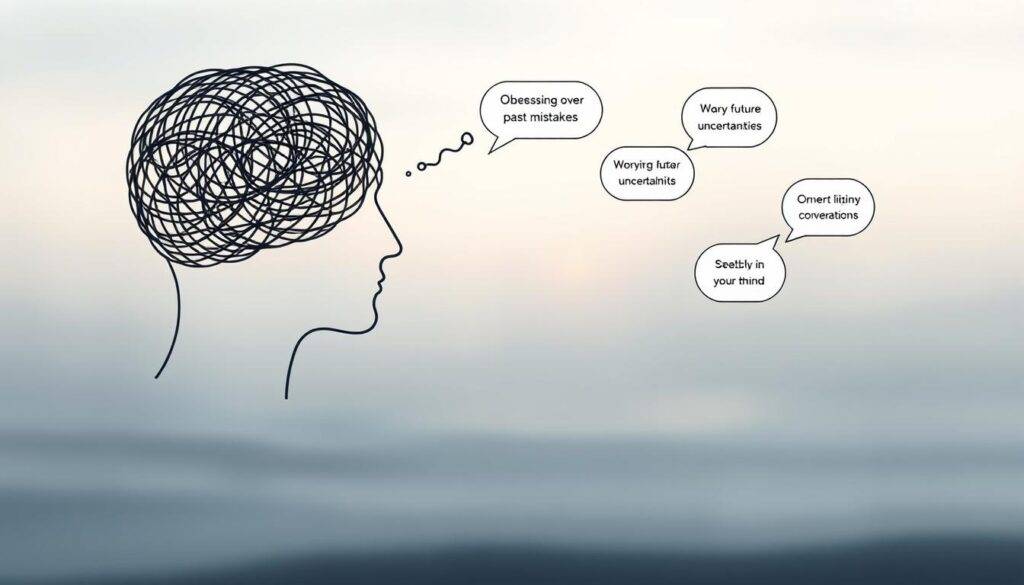What if the key to productivity isn’t working harder—but thinking less? While planning and reflection matter, endless rumination often traps people in cycles of self-doubt. Research shows that chronic overanalysis drains mental energy—leaving little room for meaningful action.
Clinical studies reveal that dwelling on problems activates stress responses, worsening fatigue and decision paralysis. This guide cuts through the noise with science-backed methods to break free from unproductive thoughts. You’ll learn how cognitive behavioral techniques and metacognitive strategies create lasting shifts.
Unlike vague self-help advice, these steps are designed for real-world application. Discover how to identify thought patterns that sabotage progress—and replace them with frameworks that fuel momentum. The goal? Transform your relationship with uncertainty and reclaim agency over your mental health.
Key Takeaways
- Overthinking depletes energy and delays meaningful action
- Actionable strategies blend cognitive science with daily habits
- Metacognition helps observe thoughts without getting stuck
- Small behavioral shifts create momentum against stagnation
- Prioritizing progress over perfection reduces mental exhaustion
Ready to trade circular thinking for forward motion? Let’s explore how to redirect that mental energy into results.
Introduction to Overthinking
Excessive mental loops drain more than just time—they hijack clarity and confidence. While problem-solving helps navigate challenges, chronic rumination traps people in negative thoughts that spiral without resolution. This guide bridges the gap between awareness and action by offering practical ways to redirect mental energy.

Purpose of the Guide
Healthy analysis weighs options. Unproductive thinking, however, replays scenarios without progress. Studies show spending over 50 minutes on decisions increases regret—not accuracy. This pattern erodes mental health by amplifying stress hormones like cortisol.
The strategies here blend cognitive behavioral therapy (CBT) principles with habit design. You’ll learn to:
- Spot when reflection becomes rumination
- Apply time-bound decision frameworks
- Replace “what if” cycles with evidence-based choices
| Healthy Analysis | Unproductive Thinking |
|---|---|
| Focuses on solutions | Repeats problems |
| Time-limited | Open-ended |
| Reduces uncertainty | Increases doubt |
By page six, you’ll master techniques to convert paralyzing thoughts into stepping stones. Let’s begin by understanding your mental patterns.
What Is Overthinking?
The mind’s endless loops often feel productive—but when does problem-solving become a trap? Overthinking occurs when reflection spirals into repetitive analysis without resolution. Unlike constructive planning, it fixates on problems rather than solutions, draining mental resources and amplifying stress.

Definition and Key Concepts
Psychologists define this pattern as rumination—replaying thoughts about past events or hypothetical situations. Key elements include:
- Cognitive distortions: Jumping to conclusions or catastrophizing outcomes
- Trigger thoughts: Specific phrases or memories that spark spirals
- Time distortion: Losing track of hours while analyzing minor details
Everyday Examples
Consider these common scenarios:
- Rehashing a work email for flaws long after sending it
- Imagining worst-case outcomes before a first date
- Second-guessing decisions like career moves or purchases
Research from Johns Hopkins University reveals that chronic rumination triples the risk of anxiety disorders. It also impairs decision-making—participants in prolonged analysis chose poorer solutions 40% more often than quick deciders.
Breaking this cycle starts with recognizing when thinking shifts from helpful to harmful. Tools like action bypasses overthinking help redirect energy toward measurable progress. Small steps build momentum, proving that mental habits can evolve with practice.
Recognizing the Signs of an Overactive Mind
How do you know when your brain’s problem-solving mode has shifted into overdrive? The body often sends signals before the mind acknowledges the strain. Physical and emotional cues act as early warning systems—if you learn to interpret them.

Physical and Emotional Indicators
Chronic mental activity leaves tangible traces. Common physical symptoms include:
- Persistent fatigue despite adequate sleep
- Restlessness or muscle tension
- Disrupted sleep patterns—trouble falling asleep or waking up exhausted
Emotionally, heightened worry often manifests as racing thoughts about hypothetical scenarios. People report feeling mentally “stuck” or battling self-doubt even during routine tasks. A 2022 UCLA study found that 68% of participants with repetitive thoughts experienced reduced concentration at work.
When It’s Time to Seek Help
While occasional analysis is normal, lasting patterns demand attention. Consider consulting a therapist if:
- Negative cycles persist for weeks
- Daily functioning becomes challenging
- Relationships suffer due to constant reassurance-seeking
As psychologist Dr. Ellen Hendriksen notes: “Awareness transforms observation into action—the first step toward regaining control.” Tracking these signals through journaling or apps helps identify triggers before they escalate.
Proactive monitoring protects mental health by interrupting destructive patterns early. Small adjustments—like scheduled worry periods—can prevent minor concerns from becoming major obstacles.
The Impact of Overthinking on Mental Health and Relationships
Mental exhaustion often starts quietly—like a phone battery draining without use. Persistent rumination doesn’t just delay decisions—it reshapes how we interact with ourselves and others. Studies reveal that excessive analysis reduces problem-solving capacity by 30% while increasing emotional fatigue.
Effects on Sleep and Energy Levels
Nighttime mental loops sabotage restorative sleep. Harvard research shows that 45% of adults with racing thoughts experience fragmented sleep cycles. This creates a vicious cycle: fatigue lowers stress tolerance, making it harder to manage daytime worries.
Chronic overanalysis also depletes energy reserves. The brain uses 20% of the body’s resources—constant thoughts drain this fuel. People report feeling “mentally hungover” even after eight hours of rest. Solutions like structured wind-down routines can break this pattern.
Strains on Personal Connections
Relationships suffer when analysis replaces presence. Partners of chronic overthinkers report:
- Frequent misunderstandings due to distracted listening
- Frustration over repeated reassurance-seeking
- Reduced intimacy from emotional withdrawal
| Healthy Communication | Overthinking Impact |
|---|---|
| Active listening | Distracted responses |
| Shared problem-solving | One-sided analysis |
| Emotional availability | Withdrawal or irritability |
Work performance also declines. A 2023 study found employees who fixate on past mistakes take 2.3x longer to complete tasks. Addressing these patterns improves mental health and rebuilds trust in personal and professional life.
Overthinking: Recognizing Patterns and Triggers
Imagine your mind as a train station—some thoughts arrive briefly before moving on, while others park indefinitely. Trigger thoughts act like locomotives pulling entire fleets of rumination. Recognizing these mental engines is key to preventing endless loops.
Identifying Trigger Thoughts
Triggers often hide in plain sight. Common culprits include unresolved conflicts, looming deadlines, or memories of past mistakes. Like a ringing phone demanding attention, these thoughts initiate cycles where analysis replaces action.
Three frequent catalysts dominate:
- Uncertainty about future scenarios
- Self-criticism over perceived failures
- Fear of others’ judgments
| Trigger Thought | Productive Response |
|---|---|
| “What if I fail?” | “What steps reduce this risk?” |
| “I should’ve done better” | “What lessons apply now?” |
| “They think I’m incompetent” | “What evidence supports my abilities?” |
Psychologist Dr. Ethan Kross explains: “Viewing thoughts as passing trains—not destinations—helps regain control.” This mental shift transforms rumination into observation. With practice, you’ll notice triggers without boarding every worry train.
Tracking patterns through journaling reveals recurring themes. Spotting these early allows intentional redirection. Over time, the brain learns to acknowledge triggers without fueling endless analysis—a skill that strengthens emotional resilience.
Actionable Steps to Overcome Negative Thoughts
Breaking free from mental loops requires tools that convert analysis into action. These evidence-based methods interrupt repetitive patterns while building decision-making confidence. Consistency turns temporary relief into lasting change.
Coping Strategies for Disrupting the Cycle
Distraction redirects energy away from unproductive thoughts. Try these when mental wheels spin:
- Physical movement: Walk while counting sidewalk cracks
- Sensory shifts: Hold ice cubes or smell peppermint oil
- Creative tasks: Fold origami or solve math problems
Cognitive reframing challenges distorted thinking. Replace “I’ll fail” with “I’ll handle outcomes as they come.” Therapist Dr. Lisa Firestone notes: “Language shapes reality—editing internal narratives rewires emotional responses.”
A Step-by-Step Approach
- Pause: Notice physical tension or racing thoughts
- Postpone: Schedule worry time (20 minutes daily)
- Process: During designated slot, journal triggers and solutions
| Strategy | Outcome |
|---|---|
| Timed reflection | Contains rumination |
| Evidence journal | Challenges assumptions |
| Action triggers | Shifts to problem-solving |
This process trains the brain to address concerns without drowning in them. Within three weeks, most users report clearer thinking and faster decision-making. Progress—not perfection—fuels momentum.
Practical Strategies for Moving Forward
When mental noise drowns out progress, action becomes the antidote. These three approaches help redirect energy from unproductive patterns to purposeful movement. Each method targets different aspects of cognitive engagement—offering multiple pathways to regain focus.
Disrupt Unhelpful Patterns
Physical exercise interrupts looping thoughts by shifting brain activity. Try alternating between these techniques:
- 5-minute dance breaks to upbeat music
- Tactical tasks like organizing a drawer
- Math puzzles requiring full concentration
| Technique | Time Investment | Outcome |
|---|---|---|
| Movement breaks | 2-5 minutes | Resets neural pathways |
| Sensory focus | 3 minutes | Grounds in present |
| Pattern tasks | 7 minutes | Engages logic centers |
Anchor in the Present
Mindfulness exercises train the mind to observe thoughts without attachment. The “5-4-3-2-1” method works instantly:
- Name 5 things you see
- Identify 4 textures you feel
- Note 3 sounds around you
A 2023 UCLA study found this reduces anxiety spikes by 41% in high-stress moments.
Restore Mental Clarity
Guided meditation apps like Calm or Headspace offer 10-minute sessions proven to lower cortisol levels. Morning routines that include breathwork create lasting focus—users report gaining 1.2 productive hours daily.
As mindfulness coach Sharon Salzberg advises: “Regular practice builds mental muscle memory for calm.” Consistency matters more than duration—even 90-second breathing exercises create cumulative benefits.
Implementing Metacognitive and Therapeutic Techniques
What if you could observe your thoughts like clouds passing through the sky—present but not permanent? Metacognitive therapy teaches exactly that. Instead of battling mental noise, this approach helps you detach from unproductive patterns. Clinical studies show it reduces anxiety by 58% when practiced consistently.
Attention Training Methods
Attention training rewires how your mind engages with distractions. Try this exercise from psychologist Dr. Adrian Wells:
- Set a timer for 3 minutes
- Focus on three distinct sounds around you
- Shift focus between them every 30 seconds
This practice strengthens your ability to redirect attention—a skill that help develop mental flexibility. Users report 34% fewer intrusive thoughts after two weeks of daily drills.
| Traditional Approach | Metacognitive Strategy |
|---|---|
| Analyzing worries | Observing thought patterns |
| Seeking certainty | Accepting uncertainty |
| Emotional reaction | Detached awareness |
Setting a Designated Worry Time
Compartmentalizing anxiety prevents it from dominating your day. Schedule 15 minutes daily to:
- Write down pressing concerns
- Rank them by solvability
- Create one actionable step for top items
Research shows this method cuts worry duration by 72% within a month. As Dr. Sarah Edelman notes: “Containment creates psychological control—you decide when issues get airtime.”
Understanding the Benefits of Therapy
Working with a therapist accelerates progress through personalized tools. Cognitive specialists help:
- Identify blind spots in thinking patterns
- Design tailored attention exercises
- Track measurable progress metrics
A 2023 Harvard study found therapy recipients resolved decision paralysis 2.1x faster than self-guided learners. This collaborative approach turns abstract concepts into daily practices that protect mental health.
Cultivating Strong Interpersonal Skills for Mental Wellness
Human connection acts as an anchor in stormy mental seas—it grounds thoughts and restores perspective. Developing interpersonal skills creates a protective layer against isolation, turning relationships into tools for emotional resilience. Studies show those with strong social ties experience 50% fewer anxiety episodes during stressful periods.
Building a Support Network
Trusted friends and mentors provide reality checks when thoughts spiral. A 2023 Stanford study found individuals with three or more close confidants resolved worries 40% faster than those without. Quality matters more than quantity—focus on depth over breadth.
Effective communication strategies include:
- Active listening without immediate problem-solving
- Expressing needs clearly using “I feel” statements
- Scheduling regular check-ins with key people
| Isolated Patterns | Supported Patterns |
|---|---|
| Internalizing stress | Sharing concerns openly |
| Assumed misunderstandings | Clarifying intentions |
| Emotional withdrawal | Seeking balanced perspectives |
Engaging with others creates natural breaks from mental loops. Shared activities—from walks to creative projects—redirect energy toward positive interactions. As psychologist Dr. Julianne Holt-Lunstad notes: “Social bonds function like cognitive shock absorbers—they soften the impact of daily stressors.”
Nurturing these connections requires intentional effort but pays dividends across all areas of life. Regular practice strengthens both relationships and mental flexibility, creating lasting buffers against unproductive thoughts.
Daily Habits to Build a Resilient Mindset
Resilience grows through consistent small choices—not grand gestures. Daily routines act as scaffolding for mental stability, creating predictable anchors in unpredictable days. Northwestern University research shows structured habits reduce stress hormones by 28% while improving emotional regulation.
Establishing a Healthy Routine
Morning rituals set the tone for the entire day. A 2023 Yale study found people who plan their first hour wake up 22% more focused. Key elements include:
- Hydration within 15 minutes of waking
- 5-minute movement sequence (stretching or yoga)
- Time-blocking priorities using the 1-3-5 rule (1 big task, 3 medium, 5 small)
| Routine Element | Benefit | Time Investment |
|---|---|---|
| Evening wind-down | Improves sleep quality | 20 minutes |
| Weekly planning | Reduces decision fatigue | 30 minutes |
| Digital detox hours | Boosts creativity | 60 minutes |
Embracing Self-Care and Gratitude
Mindfulness practices rewire the brain’s response to stress. Neuroscientists at UC Berkeley discovered daily gratitude journaling increases serotonin production by 23%. Try these evidence-based methods:
- Three deep breaths before meals to reconnect with your body
- Evening “rose-thorn-bud” reflection (highlight, challenge, hope)
- Scheduled “me time” for creative hobbies or nature walks
As psychologist Dr. Emma Seppälä notes: “Self-care isn’t selfish—it’s strategic. Protected recharge time fuels sustainable progress.” These habits transform fleeting feelings of calm into lasting mental fortitude.
Building resilience requires patience—not perfection. Start with one new habit this week. Track progress in a visible planner. Over time, these intentional choices become automatic defenses against unproductive thoughts.
Conclusion
Breaking free from mental gridlock begins with recognizing when analysis stops serving you. Chronic overthinking drains energy, strains relationships, and traps people in cycles of rumination that obscure solutions. The strategies explored here—from cognitive reframing to mindfulness practices—offer tangible ways to reclaim mental clarity.
By identifying trigger thoughts and implementing timed decision-making, you regain control over spiraling patterns. Small actions like scheduled worry periods or sensory grounding exercises disrupt negative feedback loops. These methods shift focus from hypothetical fears to evidence-based choices.
Progress hinges on consistent practice, not perfection. Each intentional step—whether journaling triggers or consulting a therapist—builds resilience against stagnation. As you apply these tools, decision-making becomes swifter and confidence grows.
You hold the power to transform mental habits. Start today: choose one strategy from this guide and implement it for seven days. Momentum builds when thought patterns align with action—proving that forward motion, not endless analysis, creates lasting change.
FAQ
How can I tell if my thoughts are becoming harmful?
Persistent rumination—like replaying past events or fearing future scenarios—often signals unproductive patterns. Physical signs include fatigue, headaches, or sleep disruptions. Emotional indicators like chronic worry or irritability also suggest it’s time to implement coping strategies or consult a therapist.
What’s the connection between anxiety and repetitive thinking?
Anxiety disorders often fuel cycles of excessive analysis, creating a feedback loop where worry amplifies stress. Techniques like cognitive-behavioral therapy (CBT) or mindfulness breaks help disrupt this cycle by refocusing attention on actionable solutions rather than hypothetical problems.
Can meditation really reduce mental clutter?
Yes. Meditative practices train the brain to observe thoughts without judgment, reducing their intensity over time. Apps like Headspace or Calm offer guided sessions that teach users to anchor themselves in the present moment, easing the grip of rumination.
When should someone seek professional help?
If negative thought patterns interfere with daily responsibilities, relationships, or physical health—or if symptoms align with depression or generalized anxiety disorder—consulting a licensed therapist is crucial. Early intervention prevents long-term effects on mental wellness.
How do “worry time” techniques work?
Designating 15–20 minutes daily to address concerns contains rumination. Writing down worries during this window helps compartmentalize them, freeing mental space for the rest of the day. This structured approach builds discipline against impulsive overanalysis.
What role does exercise play in managing stress?
Physical activity lowers cortisol levels and increases endorphins, directly countering anxiety’s physiological effects. Even brief walks or yoga sessions disrupt stagnant thought cycles by shifting focus to bodily sensations and immediate surroundings.
How can gratitude practices improve mindset resilience?
Regularly noting positive experiences—through journaling or verbal affirmations—strengthens neural pathways associated with optimism. This habit gradually reduces the brain’s tendency to fixate on perceived threats, fostering emotional balance.




























































